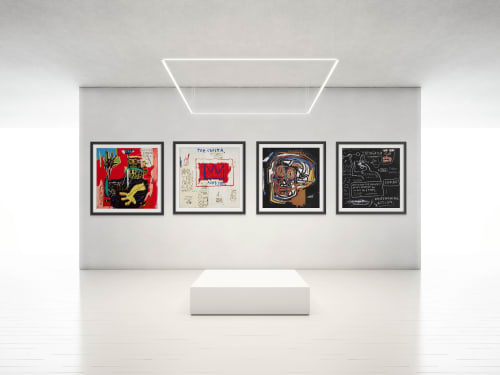Portfolio I exemplifies Basquiat’s signature style and his sharp reflection of contemporary society.
This collection captures Jean-Michel Basquiat as a groundbreaking artist with deep cultural awareness. Drawing from his urban roots and Afro-Caribbean heritage, Basquiat merged these influences with his Neo-Expressionist approach to create works that broke into spaces not traditionally welcoming to such art. The four prints in Portfolio I not only showcase his distinctive mastery of paint but also embody his talent for capturing the pulse of modern society. Published by the Jean-Michel Basquiat estate and overseen by his father Gerard, who signed each piece on the back, this portfolio offers a striking selection of his work.
One of Basquiat’s most iconic images, Untitled (Head), stands out with bold colors set against a stark black background. The rounded white areas suggest skull bones, while red and brown shades define key facial features. Despite the skull's eerie appearance, the head feels alive, expressive, and alert. This tension between life and death prompts viewers to question Basquiat’s intent. The blending of a skull with a dynamic face reflects Basquiat’s nuanced exploration of the inner self and how it's perceived by the outside world. By depicting his personal struggles—such as racism, isolation, and addiction—Basquiat revealed his most intimate emotions, connecting his experience to broader human conflicts.
Basquiat's vibrant, colorful style revived elements like the human figure, which had been largely absent in the minimalist and abstract works that came before him. His fascination with the human form, sparked by a childhood gift of Grey’s Anatomy, explains the recurring motifs of skulls and disjointed body parts in his work. In Untitled (Ernok), for example, a man is depicted with an x-ray view of veins in his transparent right hand. His surprised expression blurs the boundary between the internal and external self. By making the body's inner workings visible, Basquiat invites viewers to question their own physicality and how they are perceived by society, particularly those marginalized or “othered.”
Beyond personal struggle, Basquiat’s work also addresses broader societal issues such as race and class. A powerful critic of consumerism, he layered text and imagery to comment on the effects of advertising. In Untitled (Rinso), his fragmented language and exaggerated images mimic a twisted infomercial, blending the upbeat tone of ads with the unsettling implication of anti-Black sentiment. Though disjointed, the language and images convey a complex critique of racism in advertising. Through his suggestive visuals, Basquiat confronts viewers with the systems of racial and economic commodification in which they unwittingly participate.
Untitled (Per Capita) highlights the combination of technique and symbolic depth that defines Basquiat’s work. Referencing his 1981 painting of the same name, this print contains layered, elusive imagery that encourages viewers to explore his broader oeuvre for further insight. The three-pointed crown, a recurring symbol in Basquiat’s art, takes center stage amidst painted-over religious motifs. Basquiat frequently used crowns or halos to honor his artistic influences and heroes, many of whom were African American athletes and artists. By elevating these cultural figures—who were rarely celebrated in Western art—Basquiat both paid tribute to their achievements and positioned himself as their successor, symbolically crowning himself. In Untitled (Per Capita), the crown is placed over the boldly written word “Asbestos,” which Basquiat often used as a symbol of corporate greed and the prioritization of profit over human health. This pairing of the crown with the title suggests a triumph of individuals over societal corruption. It can be interpreted as an affirmation of Basquiat’s belief that people, like himself, can rise above adversity and make an impact, as he did within the art world.
Disover Jean-Michel Basquiat prints for sale and contact info@guyhepner.com. Looking to sell?. We will help you. Find out how to sell Basquiat prints at Guy Hepner.

